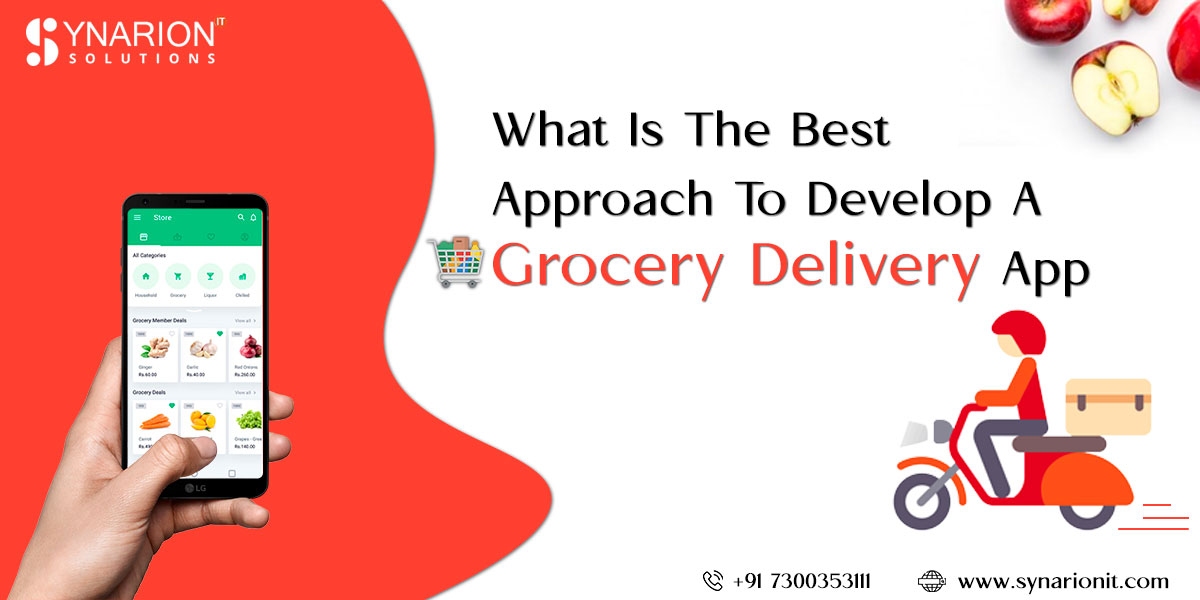Online grocery shopping is acquiring up the market and consumers' agenda rapidly. According to research, the online grocery market would culminate in growth with a CAGR of 23.7% by the end of 2025. Also, it is expected that the grocery e-commerce business would shoot up to $250 billion in the upcoming period of five years. The shift of pattern from traditional brick-and-mortar stores to online grocery delivery of app development has reduced the barriers and unlocked opportunities for conventional grocery stores, startups, and tech companies to invest in grocery mobile development projects.
Are you planning to develop a grocery mobile app development in India? let's understand crucial aspects to set up an outstanding business model.
Types of Online grocery delivery apps
Being into a highly competitive market, it is vital to determine from the inception which type of grocery delivery mobile app you should develop for your business. Capital investment, operations, resources, and services, everything relies on the kind of app you are going to construct and provide to customers. Usually, there are prominent four kinds of app players in the market -
Marketplace grocery apps
Grocery e-commerce websites like BigBasket, have their own menus, delivery drivers to pick up and deliver products to customer doorstep. In case you don't have prior experience in the grocery-related business and want to pursue a grocery app or website, this model is suitable for you. Big Basket and Grofers are such examples.
Aggregator Grocery delivery app
The aggregator model works when you collaborate with local grocery stores for products and deliver them to consumers. They use affiliate drivers to deliver the products. One such prominent player in the Indian market is the Flipkart grocery app.
Grocery Chains
Big Boomers like Jio Mart and Dmart have their own dedicated apps for customers. They have a synchronized chain with their offline stores so that consumers can get orders smoothly and swiftly.
Single store
Single stores have their apps to regulate the demands of customers. From building, management, taking orders, and delivery, everything is managed by a single store.
Features to Integrate While Grocery Delivery Mobile App Development
Every business and app has its own set of features and functionalities to be integrated. In grocery delivery app development, there are three prominent entities - Customer, Store owner, and Admin; each has its own features and functionalities.
Grocery Delivery App Customer Panel
Registration
Browsing options
Advanced Search
Multiple payment Mode
Scheduled delivery
Order tracking
Settings
Feedbacks and ratings
Store owner panel
Store Locator
Store pickup
Managing profile
Live tracking path
Admin
Store management
Coordination with stores
Payment management
Notification
Customer management
Order tracking
Product list management
Advanced Features for Grocery Delivery App Development
Beyond the general grocery app features, to stand out in a competitive market, your prospectus should have a unique selling point with some advanced features.
Effortless onboarding
When we say "effortless," it means it should be simplified and finished in a few clicks. Users don't have to go through huge tedious forms or tweak geolocation settings to activate their account.
Multiple Payment options
The majority of apps supports cash, credit cards, wallets, etc. But it would be best if you integrate multiple payment options like UPI, GPay, Paytm, and others to provide flexibility to consumers. Some apps allow users to scan the bank card and save time on the manual insertion of numbers.
Promotional offers, codes, gift cards are the best alternative to traditional payment methods.
Notification / right to information
Whether the courier is delayed due to a traffic jam or the grocery list is incomplete due to 'xyz' reason, the customer ought to know the reason for the delay through notification. They should have accessibility to view the location of the courier and the estimated time for arrival.
Easy check out
UX should be user-friendly, intuitive, and simplified. UX flows in grocery delivery app impact the customer's need and experience. It should be quick, seamless, and easy: pick up items, add to the shopping bag, go for payment, and boom, your order is confirmed.
Voice recognition
Busy customers tend to go for voice-over writing as it enables them to place orders on the go without having to type with accurate spellings or as per store inventory.
Phone or chat support
Be it technical or operational, consumers should get a dedicated team or staff for support to contact the delivery person if there are any changes related to the order.
Additional or customized features could surge up the cost of grocery app development in India. Still, users have the choice to opt for readymade grocery app development too, which is relatively affordable compared to others.
Cost for grocery app development
Multiple factors add to the cost of grocery app development, such as platform, integrated features, advanced features, readymade or custom made, business model, and much more.
The time frame also plays a prominent role in the app-building process. The time consumed for mobile apps on iOS and Android is somewhere around 20 to 30 days for customer apps, while for a delivery app, it takes 30 to 40 days. However, the entire cost and time scenario is relevant to the approach and strategies you choose.


Comments
Post a Comment